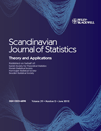
SCANDINAVIAN JOURNAL OF STATISTICS
Scope & Guideline
Exploring the frontiers of statistics and probability.
Introduction
Aims and Scopes
- Theoretical Statistics:
The journal publishes papers that contribute to the theoretical foundations of statistics, including asymptotic theory, statistical inference, and model selection. - Statistical Methodology:
Research that develops new statistical methods or improves existing techniques, particularly in areas such as regression analysis, time series, and multivariate statistics. - Applied Statistics:
The journal emphasizes the application of statistical methods in various fields such as epidemiology, finance, and social sciences, showcasing real-world problems and solutions. - Bayesian Statistics:
A significant focus is on Bayesian approaches to statistical modeling and inference, reflecting the growing importance of Bayesian methods in modern statistics. - High-Dimensional Data Analysis:
Research addressing challenges posed by high-dimensional data, particularly in areas like machine learning, genomics, and complex systems. - Nonparametric Methods:
The journal includes studies on nonparametric statistical methods, providing tools for analysis without strict parametric assumptions. - Statistical Computing:
Papers that explore computational techniques and algorithms for statistical modeling and inference, including advancements in software and simulation methods.
Trending and Emerging
- Machine Learning and Data Science:
An increasing number of papers focus on integrating machine learning techniques with statistical methodologies, highlighting the intersection of statistics and data science. - Bayesian Nonparametrics:
There is a growing trend towards Bayesian nonparametric methods, which allow for more flexible modeling without strict parametric assumptions, catering to complex datasets. - Functional Data Analysis:
The journal has seen an uptick in research related to functional data analysis, addressing challenges in analyzing data that vary over a continuum, such as time or space. - Network and Graph Statistics:
Emerging themes include statistical methods for analyzing network and graph data, reflecting the increasing importance of network structures in various fields. - Causal Inference:
Papers focusing on causal inference methods have gained prominence, reflecting a growing interest in understanding causal relationships in observational data. - High-Dimensional Inference:
A significant increase in research tackling high-dimensional inference problems is evident, emphasizing the need for robust methods in contexts with many variables relative to observations.
Declining or Waning
- Classical Hypothesis Testing:
There seems to be a reduced focus on classical hypothesis testing methods, as more researchers gravitate towards methods that accommodate complex data structures and modern statistical paradigms. - Traditional Linear Models:
Research centered around traditional linear regression models appears to be less frequent, possibly due to the rise of more flexible modeling techniques that can handle non-linearity and high-dimensional settings. - Frequentist Methods:
The prevalence of frequentist approaches may be waning, with a noticeable shift towards Bayesian methodologies that offer more intuitive interpretations and flexibility in modeling. - Basic Descriptive Statistics:
Papers focusing solely on basic descriptive statistics or simple inferential techniques have become less common, as the field moves towards more sophisticated analyses. - Simple Time Series Models:
There is a declining interest in basic time series models, as researchers increasingly explore complex time series methodologies that address non-stationarity and high dimensionality.
Similar Journals
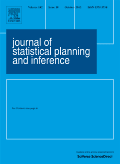
Journal of Statistical Planning and Inference
Empowering Research Through Rigorous Statistical InsightsThe Journal of Statistical Planning and Inference, published by ELSEVIER, stands as a significant platform within the fields of applied mathematics and statistics. With a history of rigorous scholarship since its inception in 1977, this journal provides a vital forum for researchers to share their advancements in statistical methodologies, planning, and inference techniques. As of 2023, it holds a respectable impact factor reflected in its Q2 rankings across multiple categories, including Applied Mathematics and Statistics and Probability, showcasing its influence and relevance in academic discourse. The journal is indexed in Scopus, with commendable rankings that affirm its scholarly merit, making it vital for professionals and students seeking the latest developments and research trends in statistical sciences. With a commitment to high-quality publications aimed at fostering innovation and practical solutions in statistical applications, the Journal of Statistical Planning and Inference is essential for anyone involved in empirical research and data-driven decision-making.
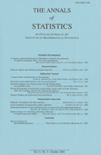
ANNALS OF STATISTICS
Pioneering the Future of Data Analysis and InterpretationANNALS OF STATISTICS, published by the Institute of Mathematical Statistics (IMS), stands as a premier journal in the field of statistical science, particularly recognized for its rigorous peer-reviewed articles and innovative contributions. With an impressive impact factor and categorized in the Q1 quartile for both Statistics and Probability, as well as Statistics, Probability, and Uncertainty, this journal is a vital resource for researchers, professionals, and students alike. Covering a comprehensive array of statistical theories and methodologies from 1996 to 2024, it aims to foster the advancement of mathematical statistics while addressing contemporary challenges in data analysis and interpretation. The journal, operating without an Open Access model, remains a key platform for disseminating high-quality research, evident from its commendable Scopus rankings of Rank #9 out of 278 in Statistics and Probability and Rank #9 out of 168 in Decision Sciences. Located in Cleveland, Ohio, the ANNALS OF STATISTICS is not just a journal but a beacon of knowledge that continues to influence statistical practices globally.

Thailand Statistician
Empowering Research Through Innovative Statistical InsightsThailand Statistician, published by the THAI STATISTICAL ASSOCIATION, is a pivotal journal in the realms of computational mathematics and statistics. With an ISSN of 1685-9057 and an E-ISSN of 2351-0676, this journal aims to disseminate high-quality research and innovative methodologies that advance the fields of statistics and probability. Covering a range of topics from theoretical statistics to applied computational techniques, it provides a platform for researchers, professionals, and students in Thailand and beyond to contribute their findings and insights. The journal has been gaining recognition, boasting a Scopus ranking of Q3 in Computational Mathematics and Q4 in Statistics and Probability as of 2023. With its commitment to open access, the Thailand Statistician stands as an essential resource for those striving to stay abreast of advancements in statistical methodologies and their applications, fostering the growth of statistical science in the region and globally.

Metron-International Journal of Statistics
Exploring the forefront of statistical knowledge since 1973.Metron-International Journal of Statistics is a prestigious peer-reviewed journal published by SPRINGER-VERLAG ITALIA SRL, dedicated to advancing the field of statistics and probability. With an ISSN of 0026-1424 and an E-ISSN of 2281-695X, this journal has been a vital platform for scholarly research since its inception in 1973, showcasing works that redefine methodologies and applications within the field. Positioning itself in Q3 of the 2023 statistics category quartiles, Metron aims to foster dialogue and innovation among researchers and practitioners. Although currently not an open-access publication, it provides invaluable insights that contribute significantly to the statistical community's body of knowledge. Serving a diverse global audience, the journal encourages submissions that address both theoretical frameworks and practical applications in statistics, promising to enhance the rigor and relevance of statistical practice. Based in Milan, Italy, Metron continues to uphold its commitment to excellence in statistical research through thorough peer review and a focus on impactful findings.
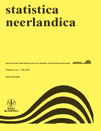
STATISTICA NEERLANDICA
Pioneering insights in the realm of statistics and probability.STATISTICA NEERLANDICA is a prestigious peer-reviewed journal published by Wiley, focusing on the fields of statistics and probability. Established in 1946 and addressing key issues in statistical theory and its applications, the journal has significantly contributed to the development of modern statistical practices. With an impressive Q2 categorization in both Statistics and Probability, as well as Statistics, Probability, and Uncertainty, STATISTICA NEERLANDICA stands out within its field, ranking in the 62nd percentile among its peers in mathematics, specifically in statistics and probability. Researchers, professionals, and students can benefit from its rigorous scholarship and innovative methodologies, aiding in the advancement of statistical science. Although the journal does not operate under an open access model, it maintains a commitment to disseminating high-quality research, making it a vital resource for those engaged in statistical inquiry.
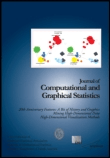
JOURNAL OF COMPUTATIONAL AND GRAPHICAL STATISTICS
Elevating research through innovative statistical methodologies.JOURNAL OF COMPUTATIONAL AND GRAPHICAL STATISTICS is a premier academic publication dedicated to advancing the fields of computational statistics and graphical data representation. Published by Taylor & Francis Inc, this journal stands out with its impressive Q1 rankings in Discrete Mathematics and Combinatorics, Statistics and Probability, and Statistics, Probability and Uncertainty, reflecting its high impact and relevance in contemporary research. Since its inception in 1992, the journal has been a vital resource for researchers, professionals, and students alike, with its rigorous peer-reviewed articles contributing significantly to the science of data analysis and visualization. With a Scopus ranking placing it within the top tiers of its category, the journal is committed to disseminating high-quality research that promotes innovation and methodological advancement. Note that the journal currently follows a traditional subscription model, ensuring focused and curated content for its readers. As it approaches the horizon of 2024, the JOURNAL OF COMPUTATIONAL AND GRAPHICAL STATISTICS continues to foster scholarly discourse and discoveries, making it an essential platform for anyone involved in statistics and data science.
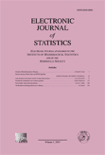
Electronic Journal of Statistics
Advancing Statistical Knowledge for AllElectronic Journal of Statistics, published by INST MATHEMATICAL STATISTICS-IMS, is a premier open-access platform dedicated to the field of statistics and probability, with a remarkable track record since its inception in 2007. With an ISSN of 1935-7524, this journal has quickly established itself as a leading resource within the top Q1 category in both Statistics and Probability, as well as Statistics, Probability and Uncertainty, highlighting its significance and impact in the academic community. The journal’s commitment to disseminating high-quality research allows researchers, professionals, and students to access valuable findings and methodologies that contribute to the advancement of statistical sciences. With its convergence set to continue until 2024, the Electronic Journal of Statistics remains a vital source for scholars looking to enrich their knowledge and engage with cutting-edge statistical theories and applications.
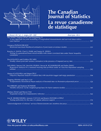
CANADIAN JOURNAL OF STATISTICS-REVUE CANADIENNE DE STATISTIQUE
Elevating Statistical Discourse Across DisciplinesCanadian Journal of Statistics - Revue Canadienne de Statistique is a prestigious publication in the field of statistics, managed by Wiley. Since its inception in 1973, this journal has served as an essential resource for researchers, practitioners, and students, offering insights into a diverse range of statistical methodologies and applications. With its impact reflected in its 2023 categorization as Q2 in Statistics and Probability and Q3 in Statistics, Probability and Uncertainty, the journal stands out among its peers, exemplifying rigorous standards in empirical research. The journal's ISSN is 0319-5724 and its E-ISSN is 1708-945X, providing a robust platform for the dissemination of knowledge in the field. While it does not offer open access, the journal remains highly regarded and well-cited, contributing significantly to the advancement of statistical theory and practice. As it continues to publish cutting-edge research through to 2024, the Canadian Journal of Statistics is a must-read for anyone seeking to stay informed on the latest trends and developments in statistics.

Advances and Applications in Statistics
Advancing Knowledge, Transforming ApplicationsAdvances and Applications in Statistics is a pivotal academic journal devoted to the dissemination of high-quality research findings in the field of statistics and its diverse applications. Published by PUSHPA PUBLISHING HOUSE, this journal aspires to serve as a dynamic platform for researchers, professionals, and students who aim to share innovative statistical methodologies and explore their practical implications across various disciplines. The journal, with its influential ISSN 0972-3617, fosters open discussion and collaboration within the statistical community, aiming to bridge theoretical advancements with real-world applications. As part of its ongoing commitment to academic integrity and excellence, Advances and Applications in Statistics encourages submissions that not only advance statistical theory but also illustrate their utility in solving contemporary issues in industries such as healthcare, finance, and economics. Although currently lacking an impact factor, the journal's dedication to quality research positions it as a significant contributor to the field. Researchers and academics looking to publish their work in a stimulating and supportive environment will find in this journal a valuable resource.

JOURNAL OF MULTIVARIATE ANALYSIS
Connecting Theory with Practical Statistical SolutionsJournal of Multivariate Analysis, published by Elsevier Inc, stands as a pivotal resource in the disciplines of Numerical Analysis and Statistics. With a history of scholarly contribution since 1971, this journal has maintained a reputation for excellence, evidenced by its Q2 ranking in critical categories as of 2023. The journal covers a wide array of topics within multivariate statistical methods and their applications, making it an essential publication for researchers, professionals, and students seeking to deepen their understanding and application of sophisticated analytical techniques. Although not open-access, the journal provides valuable insights into the ever-evolving fields of statistics and probability, enabling readers to access and contribute to cutting-edge research up to the year 2024. By addressing significant theoretical and practical challenges in statistical analysis, Journal of Multivariate Analysis fosters a community of intellectual rigor and innovation.